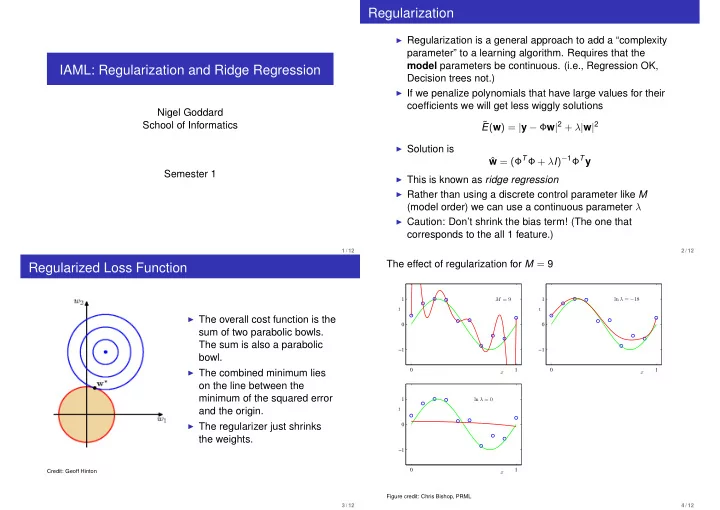

Regularization ◮ Regularization is a general approach to add a “complexity parameter” to a learning algorithm. Requires that the model parameters be continuous. (i.e., Regression OK, IAML: Regularization and Ridge Regression Decision trees not.) ◮ If we penalize polynomials that have large values for their coefficients we will get less wiggly solutions Nigel Goddard E ( w ) = | y − Φ w | 2 + λ | w | 2 ˜ School of Informatics ◮ Solution is w = (Φ T Φ + λ I ) − 1 Φ T y ˆ Semester 1 ◮ This is known as ridge regression ◮ Rather than using a discrete control parameter like M (model order) we can use a continuous parameter λ ◮ Caution: Don’t shrink the bias term! (The one that corresponds to the all 1 feature.) 1 / 12 2 / 12 The effect of regularization for M = 9 Regularized Loss Function ln λ = − 18 1 M = 9 1 t t ◮ The overall cost function is the 0 0 sum of two parabolic bowls. The sum is also a parabolic −1 −1 bowl. ◮ The combined minimum lies 0 1 0 1 x x on the line between the minimum of the squared error 1 ln λ = 0 and the origin. t ◮ The regularizer just shrinks 0 the weights. −1 0 1 Credit: Geoff Hinton x Figure credit: Chris Bishop, PRML 3 / 12 4 / 12
M = 9 1 Training For standard linear regression, we had Test ◮ Define the task : regression E RMS 0.5 ◮ Decide on the model structure : linear regression model ◮ Decide on the score function : squared error (likelihood) ◮ Decide on optimization/search method to optimize the score function: calculus (analytic solution) 0 −35 −30 −25 −20 ln λ Chris Bishop, PRML 5 / 12 6 / 12 A Control-Parameter-Setting Procedure But with ridge regression we have ◮ Define the task : regression ◮ Regularization was a way of adding a “capacity control” ◮ Decide on the model structure : linear regression model parameter. ◮ Decide on the score function : squared error with ◮ But how do we set the value? e.g., the regularization quadratic regularizaton parameter λ ◮ Decide on optimization/search method to optimize the ◮ Won’t work to do it on the training set (why not?) score function: calculus (analytic solution) ◮ Two choices to consider: ◮ Validation set Notice how you can train the same model structure with ◮ Cross-validation different score functions. This is the first time we have seen this. This is important. 7 / 12 8 / 12
Using a validation set Example of using a validation set Consider polynomial regression: ◮ Split the labelled data into a training set, validation set, and 1. For each m = 1 , 2 , . . . M (you choose M in advance a test set. 2. Train the polynomial regression using ◮ Training set: Use for training φ ( x ) = ( 1 , x , x 2 , . . . , x m ) T on training set (e.g., by ◮ Validation set: Tune the “control parameters” according to minimizing squared error). This produces a predictor f m ( x ) . performance on the validation set 3. Measure the error of f m on the validation set ◮ Test set: to check how the final model performs 4. End for ◮ No right answers, but for example, could choose 60% 5. Choose the f m with the best validation error. training, 20% validation, 20% test 6. Measure the error of f m on the test set to see how well you should expect it to perform 9 / 12 10 / 12 Continuous Control Parameters Continuous Control Parameters ◮ For a discrete control parameter like polynomial order m ◮ For a discrete control parameter like polynomial order m we could simply search all values. we could simply search all values. ◮ What about a quadratic regularization parameter λ . What ◮ What about a quadratic regularization parameter λ . What do we do then? do we do then? ◮ Pick a grid of values to search. In practice you want the grid to vary geometrically for this sort of parameter. e.g., Try λ ∈ { 0 . 01 , 0 . 1 , 0 . 5 , 1 . 0 , 5 . 0 , 10 . 0 } . Don’t bother trying 2 . 0, 3 . 0, 7 . 0. 11 / 12 12 / 12
Recommend
More recommend